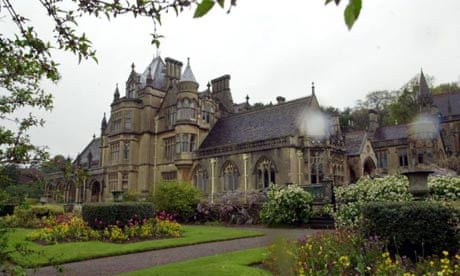Cataloguing the clutter and everyday items that make up the contents of a family house is an unenviable task. But when the property in question is a 43-bedroom house that was occupied continuously by four generations of the same family "who kept everything", the task becomes that little bit harder.
Since January 2004, National Trust staff and volunteers have been faced with just such a daunting project at Tyntesfield, a Grade I-listed Victorian property in north Somerset, near Bristol.
The cataloguers have just recorded their 30,000th item and expect that by the end of the painstaking process, which is likely to last another year, they will have recorded the details of more than 40,000 objects. So far the project has thrown up everything from the mundane - the plastic bags of the late Lord Wraxall, the last inhabitant of Tyntesfield before it was acquired by the trust after a remarkably successful public appeal - to the bizarre: item 29,999 was a sinister-looking coconut, hollowed out and with a face carved into it and plant fibres added for hair.
The origin of the coconut, which sits in the gun room, only recently opened to the public, is unknown, but the Gibbs family, who occupied the house, were a well-travelled clan. Antony, who began the business empire on which Tyntesfield was built, was an international wool merchant. His sons made their fortune from importing seabird droppings for use as fertiliser from South America, while Wraxall (George Gibbs) served in the Coldstream Guards and the local Yeomanry regiment.
Among other objects discovered at the property were a jewel-encrusted chalice, moth-eaten teddy bears and unused Christmas crackers. A prime find has been a spare roll of original 19th-century flock wallpaper. The same design currently hangs in an anteroom and the discovery demonstrates how different the room would have looked when it was first decorated. Ruth Moppett, the inventory supervisor, described the change in colour as "quite amazing", from "plush mink" on the unused roll to "orangey gold" on the walls.
Tyntesfield was saved for the nation in 2002 after Wraxall died and a public appeal saw more than 77,000 people donate £8.2m in 100 days. The project to buy the house also attracted the largest ever single grant, £17.4m, from the National Heritage Memorial Fund.
The spectacular Gothic revival house captured the imagination of the public, but there were critics who felt that it was not sufficiently old and distinctive to warrant the expense. However, for Tyntesfield's visitor services and enterprise manager, Rebecca Aubrey-Fletcher, the finds provide compelling justification for the purchase.
"It's quite unique, four generations of the Gibbs family who kept everything - they really did keep everything," she said. "The interesting thing about it is the range of items, from the 19th-century objects to Lord Wraxall's 20th-century washing machine."
So far, the contents of 65 rooms have been recorded, with another 10 remaining, plus the stables and gardens. Among the items yet to be catalogued are parts of the textile collection.
The plan is that eventually the fully photographed inventory will be put online so the public can view the miscellany on their computers. Conservation on the property is continuing, as is fundraising, with a target date for completion of renovation work of 2012. But the estate remains open to the public, who have flocked to Tyntesfield in increasing numbers since it was opened up weeks after being bought by the trust.
Visitors can see almost all of the items catalogued, although there is one notable exception. An unexploded second world war bomb was found sitting on a shelf in the old servants' hall shortly after the inventory process began.
"He [Lord Wraxall] was a soldier, so perhaps he wanted it as a souvenir," said Aubrey-Fletcher. "Unfortunately, that was taken away."
Odds and ends
· Unexploded second world war bomb
· Jewel-encrusted chalice
· Roll of 19th-century flock wallpaper
· Coconut with carved face and hair
· Toolkit including handmade templates for use around the estate
· Moth-eaten teddy bears
· Unused Christmas crackers
· Lord Wraxall's plastic bags
